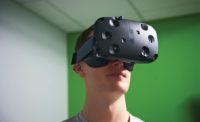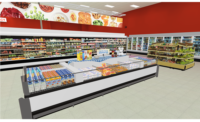Create Better Packaging Displays Using Virtual Reality

It’s increasingly difficult to defend packaging and store displays that result in underwhelming sales. Technology and access to consumer data are better than ever, ensuring that as consumer shopping continues to grow, sales should as well. As part of this technological and data evolution, retailers and manufacturers are rethinking their approach to design. Integrating tools like virtual reality (VR) is helping them to make well-informed decisions during the design process that mitigate risk and improve the bottom line.
Conceptualization in its current state is a wasteful element to design. It takes hours to collect inspirational whiteboard ideas that will come to life in the form of expensive physical mock-ups, all of which eventually end up in the garbage. However, using VR, companies can bypass this expensive and time-consuming step by quickly importing art files and sharing them across teams in a collaborative hyper-realistic retail environment. Within this environment, companies can iterate concepts on the fly while also visualizing them in the context of actual retail environments. For example, designers can make sure new concepts stand out from the blue of Walmart or the red of Target.
PREDICTING SHOPPER BEHAVIOR
Similar to conceptualization, evaluation traditionally wastes time and money. The process of setting up display concepts and recruiting individuals to participate in surveys and focus groups is outrageously time consuming and expensive. With VR, companies can slim down resources by conducting side-by-side, in-depth analyses of several concepts in multiple stores to obtain real shopper data that will accurately predict customer behavior. Just think of the benefits for a company like Starbucks that could better predict the reaction to its holiday cups.
And because of the ability to test in VR, there’s no need to conduct confusing and disruptive in-store focus group tests in June or July only to be left agonizing over whether the design will still be relevant come November or December. VR provides the ability to start the planning process early and have ample time to make adjustments to messaging and artwork.
VR also enhances the communication and collaborative functions of the design process. With executives and partners often geographically scattered, companies rely heavily on email and phone to make design refinements. A minuscule mistake could create a difference in a color that varies from brand standards.
Once winning designs are chosen, executives are often flown around the country or the world to see mock-ups and conduct in-person testing. With VR, collaboration becomes seamless, notes can be placed, seen and edited by everyone. And, with the introduction of hyper-realistic visuals as opposed to flat, boring images, executives can stay put with the confidence that the image is “virtually” the same as a physical mockup.
The process of integrating technologies like VR into design will become the new normal over the next three to five years. As consumer spending increases, companies will be challenged to create new packaging and displays year after year that continue to attract consumers and move product. Smart companies are not only looking at innovative designs but also at how to cut costs and time associated with the design process—areas where VR can make a real impact.
Looking for a reprint of this article?
From high-res PDFs to custom plaques, order your copy today!





